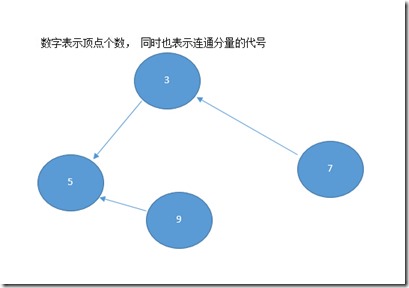今天又爆零了,又是又,怎么又是又,爆零爆多了,又也就经常挂嘴边了,看到这句话,你一定很想说一句”![KX9HZK]4LPXQ]63U2%VM$NX KX9HZK]4LPXQ]63U2%VM$NX](https://images0.cnblogs.com/blog/591699/201408/102247362257728.jpg) ”,弱菜被骂傻,也很正常啦
”,弱菜被骂傻,也很正常啦 。
。
如果你不开心,可以考虑往下看。
翻到E(HDU 4635 Strongly connected)题,这么短的题目,肯定要先看啦。然后D(LightOJ 1229),然后C(ZOJ 2243),然后F(HDU 4711),然后B(CodeForces 385D),然后看A(HDU 3889)好吧,我承认,A题看了一眼就不看了,B题一看是线段什么有点几何的味道就果断放弃,然后C题,傻傻的理解错题意,提交一直WA,然后没办法,看E题,![AV5W2LR]H5YAQXT}1N2LPDY AV5W2LR]H5YAQXT}1N2LPDY](https://images0.cnblogs.com/blog/591699/201408/102247403811230.gif) 想到只要保证最后至少两个连通分量,就可以满足题意,然后要求最大值,那就保证有且仅有两个连通分量就可以了,对于一个连通分量最多只能有x(x-1)边, x表示顶点数 ,然后得出一个式子,边数f = n*n-n-1+x*x-(n+1)x;当x更(n+1)/2的差值越大,f越大,换句话说,只要把一个连通分量顶点个数最小的独立出来,把其它的连通分量都合并成一个连通分量就可以了,
想到只要保证最后至少两个连通分量,就可以满足题意,然后要求最大值,那就保证有且仅有两个连通分量就可以了,对于一个连通分量最多只能有x(x-1)边, x表示顶点数 ,然后得出一个式子,边数f = n*n-n-1+x*x-(n+1)x;当x更(n+1)/2的差值越大,f越大,换句话说,只要把一个连通分量顶点个数最小的独立出来,把其它的连通分量都合并成一个连通分量就可以了,
可是我没考虑下面这种情况

这时候如果把3独立出来,5、9、7弄成一个连通分量,那么3也会跟5,9,7合并成一个连通分量,所以不能选3,
最小的不能选,那就选5吧,把3、7、9合并,可以。
也就是说是要把顶点个数尽量小且入度或者初度为零(一个连通分量看成一个点)的连通分量独立出来。


view code#include <iostream>
#include <cstdio>
#include <cstring>
#include <queue>
#include <algorithm>
#include <cmath>
#include <vector>
#include <map>
#include <stack>
using namespace std;
typedef long long ll;
const int INF = 0x3f3f3f3f;
const int N = 100010;
int _, cas=1, n, m;
int in[N], out[N], num[N];
vector<int > G[N];
int pre[N], lowlink[N], dfs_clock, scc_cnt, sccno[N];
stack<int >S;
void dfs(int u)
{
pre[u] = lowlink[u] = ++dfs_clock;
S.push(u);
int siz = G[u].size();
for(int i=0; i<siz; i++)
{
int v = G[u][i];
if(!pre[v])
{
dfs(v);
lowlink[u] = min(lowlink[u], lowlink[v]);
}
else if(!sccno[v])
{
lowlink[u] = min(lowlink[u], pre[v]);
}
}
if(lowlink[u] == pre[u])
{
scc_cnt++;
for(;;)
{
int x = S.top(); S.pop();
sccno[x] = scc_cnt;
num[scc_cnt]++;
if(x==u) break;
}
}
}
void find_scc()
{
dfs_clock = 0;
scc_cnt = 0;
memset(sccno, 0, sizeof(sccno));
memset(pre, 0, sizeof(pre));
for(int i=1; i<=n; i++)
{
if(!pre[i]) dfs(i);
}
}
void solve()
{
scanf("%d%d", &n ,&m);
memset(num, 0, sizeof(num));
memset(in, 0, sizeof(in));
memset(out, 0, sizeof(out));
for(int i=1; i<=n ;i++) G[i].clear();
int u, v;
for(int i=0; i<m; i++)
{
scanf("%d%d", &u, &v);
G[u].push_back(v);
}
find_scc();
printf("Case %d: ", cas++);
if(scc_cnt==1)
{
printf("-1
");
return ;
}
ll ans = 0, Min = INF;
for(int i=1; i<=n; i++)
{
int siz = G[i].size();
for(int j=0; j<siz; j++)
{
if(sccno[i]!=sccno[G[i][j]])
{
in[sccno[G[i][j]]]++;
out[sccno[i]]++;
}
}
}
for(int i=1; i<=scc_cnt; i++)
{
if((in[i]==0 || out[i]==0) && Min>num[i]) Min = num[i];
// printf("num[%d] = %d
", i, num[i]);
// printf("out = %d, in = %d
", out[i], in[i]);
}
ans = (Min-1)*Min- m + (n-Min)*(n-Min-1)+Min*(n-Min);
cout<<ans<<endl;
}
int main()
{
// freopen("in", "r", stdin);
cin>>_;
while(_--) solve();
return 0;
}
红色部分就是思维漏洞
。差一点,不过acm没有差一点,只有ac或者没ac.
下面再来总结一下题目吧
Problem A
HDU 3889(水题,不会做)
Problem B
CodeForces 385D(dp,题意尚不明确)
Problem C
ZOJ 2243(什么treap,被坑)
笛卡尔树:
每个节点有2个关键字key、value。从key的角度看,这是一颗二叉搜索树,每个节点的左子树的key都比它小,右子树都比它大;从value的角度看,这是一个堆。
题意:以字符串为关键字key,数字为关键字value,构造一个二叉搜索大堆,最后按要求中序遍历 笛卡尔树的构造。


view code#include <iostream>
#include <cstdio>
#include <cstring>
#include <algorithm>
#include <queue>
#include <vector>
using namespace std;
#define lson l,m,rt<<1
#define rson m+1,r,rt<<1|1
const int N = 55555;
const int INF = 1<<30;
int n, pos[N<<2], Max[N<<2];
struct node
{
char str[55];
int data;
bool operator < (const node &o) const{
return strcmp(str,o.str)<0;
}
}sto[N];
void Up(int rt)
{
int ls = rt<<1, rs=ls|1;
if(Max[rs]>Max[ls]) pos[rt] = pos[rs], Max[rt] = Max[rs];
else pos[rt] = pos[ls], Max[rt] = Max[ls];
}
void build(int l, int r, int rt)
{
if(l==r)
{
Max[rt] = sto[l].data;
pos[rt] = l;
return ;
}
int m = (l+r)>>1;
build(lson);
build(rson);
Up(rt);
}
int query(int L, int R, int l, int r, int rt)
{
if(L<=l && R>=r) return pos[rt];
int m = (l+r)>>1;
if(R<=m) return query(L, R, lson);
if(L>m) return query(L, R, rson);
int lpos = query(L, R, lson);
int rpos = query(L, R, rson);
return sto[lpos].data<sto[rpos].data?rpos:lpos;
}
void print(int l, int r)
{
if(l>r) return ;
if(l==r)
{
printf("(%s/%d)", sto[l].str, sto[l].data);
return ;
}
int m = query(l, r, 0, n-1, 1);
printf("(");
print(l, m-1);
printf("%s/%d", sto[m].str, sto[m].data);
print(m+1,r);
printf(")");
}
void solve()
{
for(int i=0; i<n; i++)
{
scanf(" %[a-z]/%d", sto[i].str, &sto[i].data);//这个输入方式。。又涨姿势了
// printf("%s/%d
", sto[i].str, sto[i].data);
}
sort(sto, sto+n);
build(0, n-1, 1);
print(0, n-1);
printf("
");
}
int main()
{
// freopen("in.txt", "r", stdin);
while(scanf("%d", &n)>0 && n) solve();
return 0;
}
//[a-z]表示读取的字符串由a-z中的字符组成,其余的字符为定界符scanf/fscanf 的%[]和%n使用方法
Problem D
LightOJ 1229(博弈,大白书P139)


view code#include <iostream>
#include <cstdio>
#include <algorithm>
#include <cstring>
using namespace std;
const int N = 222;
int _, cas=1, n;
int sg[N] = {0, 1, 1, 1};
bool vis[N];
char s[N];
void init()
{
int i, j;
for(i=4; i<=200; i++)
{
memset(vis, 0, sizeof(vis));
for(j=3; j<=5 && j<=i ; j++) vis[sg[i-j]] = 1;
for(j=1; j+5<i; j++) vis[(sg[j]^sg[i-j-5])] = 1;
for(j=0; ; j++) if(!vis[j]) break;
sg[i] = j;
}
// for(int i=0;i <20; i++) printf("sg[%d] = %d
", i, sg[i]);
}
bool is_ok(int pos)
{
if(pos>2 && s[pos-2]=='X' &&s[pos-1]=='X') return true;
if(pos>1 && pos<n && s[pos-1]=='X' && s[pos+1]=='X') return true;
if(pos<n-1 && s[pos+1]=='X' && s[pos+2] == 'X') return true;
for(int k=pos-2; k<=n && k<=pos+2; k++)
{
if(k<1) continue;
if(s[k]=='X') return 0;
}
return 1;
}
bool win(int pos)
{
for(int i=3; i<=n; i++) if(s[i]=='X'&&s[i-1]=='X'&&s[i-2]=='X') return true;
for(int i=1; i<=n; i++)
{
if(i>2 && s[i-2]=='X' &&s[i-1]=='X') return 0;
if(i>1 && i<n && s[i-1]=='X' && s[i+1]=='X') return 0;
if(i<n-1 && s[i+1]=='X' && s[i+2] == 'X') return 0;
}
int ans = 0, pre = 1;
for( ; ; )
{
while(pre<=n && s[pre]=='X') pre++;
if(pre>n) break;
int k = pre;
while(k<=n && s[k]=='.') k++;
if(k<=n && pre>1 && s[pre-1]=='X'){
if(s[k]=='X' && k-pre-4>0) ans ^= sg[k-pre-4];
}
else if(k-pre-2>0) ans ^= sg[k-pre-2];
if(k>n) break;
pre = k;
}
return ans==0;
}
void solve()
{
scanf("%s", s+1);
n = strlen(s+1);
printf("Case %d:", cas++);
int f = 1;
for(int i=1; i<=n; i++)
{
if(!is_ok(i)) continue;
s[i] = 'X';
if(win(i))
printf(" %d", i), f = 0;
s[i] = '.';
}
if(f) printf(" 0");
puts("");
}
int main()
{
// freopen("in.txt", "r", stdin);
init();
cin>>_;
while(_--) solve();
return 0;
}
Problem E
HDU 4635(。。。。。。。。。。。。。。。。。,此处省略一万字)
Problem F
HDU 4711 。。
![KX9HZK]4LPXQ]63U2%VM$NX KX9HZK]4LPXQ]63U2%VM$NX](https://images0.cnblogs.com/blog/591699/201408/102247362257728.jpg) ”,弱菜被骂傻,也很正常啦
”,弱菜被骂傻,也很正常啦 。
。![]() 想到只要保证最后至少两个连通分量,就可以满足题意,然后要求最大值,那就保证有且仅有两个连通分量就可以了,对于一个连通分量最多只能有x(x-1)边, x表示顶点数 ,然后得出一个式子,边数f = n*n-n-1+x*x-(n+1)x;当x更(n+1)/2的差值越大,f越大,换句话说,只要把一个连通分量顶点个数最小的独立出来,把其它的连通分量都合并成一个连通分量就可以了,
想到只要保证最后至少两个连通分量,就可以满足题意,然后要求最大值,那就保证有且仅有两个连通分量就可以了,对于一个连通分量最多只能有x(x-1)边, x表示顶点数 ,然后得出一个式子,边数f = n*n-n-1+x*x-(n+1)x;当x更(n+1)/2的差值越大,f越大,换句话说,只要把一个连通分量顶点个数最小的独立出来,把其它的连通分量都合并成一个连通分量就可以了,

